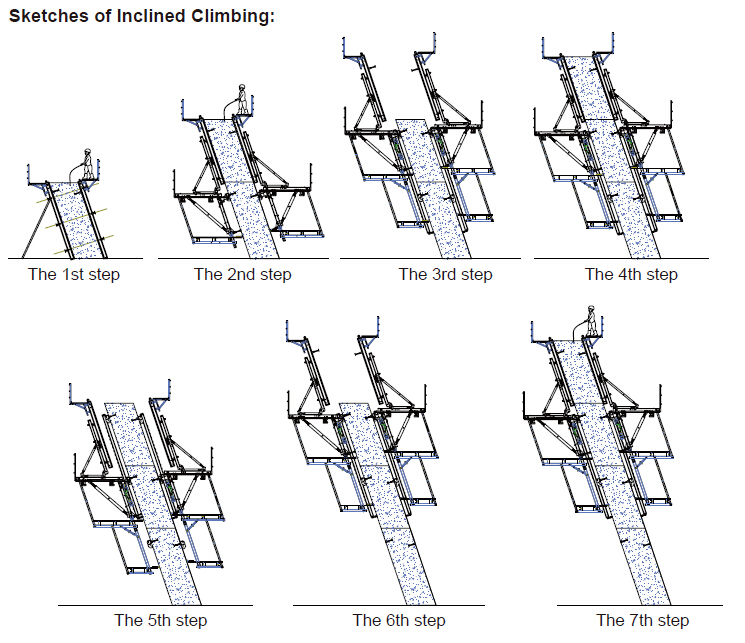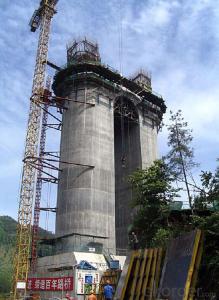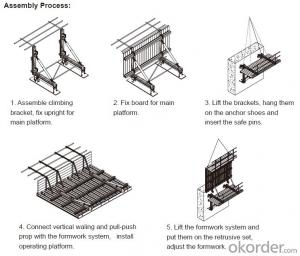Auto Climbing Bracket ACB100&ACB50 for formwork and scaffolding system
- Loading Port:
- Tianjin
- Payment Terms:
- TT OR LC
- Min Order Qty:
- 50 m²
- Supply Capability:
- 1000 m²/month
OKorder Service Pledge
OKorder Financial Service
You Might Also Like
Auto-climbing Bracket ACB100 & ACB50
The power of the auto-climbing formwork is the hydraulic system, which includes the oil cylinder
and two commutators. The commutators can control the climbing of climbing rail and the bracket.
The steel rail and the bracket can inter-climbing, so the whole system will climb up steadily.
Cranes are not needed during the construction. It’s easy to operate, highly efficient and safe. It’s
the best choice for the construction of high buildings and bridges.
There are mainly two types of standard auto-climbing brackets, ACB-50 and ACB-100, the figure
means the push power of cylinder with unit of KN.
Characteristics:
◆ Perfect load bearing anchor system
Anchor system is the most important supporting part. The system is made of five parts shown
below. Thereinto, tensile bolt, V-climbing cone and washer can be taken out for reusing after the
concrete pouring finished.There are two kinds of anchor systems,A & B. A is matched with single
anchor shoe and B is matched with double anchor shoe.
◆ Crane-independent
Crane-independent forming, striking and climbing speeds up the work procedures on the
construction site and also makes them independent of each other. This means the planned
sequences can be maintained along with guaranteeing high productivity levels. The crane can
therefore be used for other tasks.
Hydraulic system is mainly made of two commutators,
oil cylinder and power distribution system.The
commutators can control the climbing of climbing rail
and bracket.
◆ High bearing capacity and safe
The stable working platforms are able to carry large loads, e.g. the storage of reinforcing steel
for the next climbing section. Generously-sized working platforms, the well thought-out design for
handling very high wind loads and the patented control function of the climbing mechanism are
some of the special details contained within the comprehensive safety concept.
◆ Platforms adjusted to suit the angle of inclination
The horizontal working areas thus created provide safe and comfortable conditions for
reinforcement work, shuttering and striking, concreting and finishing.
◆ The ACB formwork system can climb not only vertically but also slantways, the largest angle is
18 degrees.
◆ The system can climb up wholly or separately. The climbing process is steady, synchronous
and safe.
◆ The bracket will not fall to the ground until the construction is finished, the field will be saved
and the impacting breakage will be reduced (especially the panel).
◆ The system will furnish omnidirectional platform, the construction organizations don’t need to
set up additional operation platform.
◆ The error of structure construction is small and easy to correct.
◆ The climbing speed is fast, the construction course will be quickened.
◆ The formwork can climb itself and cleaning work can be done in the same situs , the used times
of tower crane will be greatly reduced.

- Q: How does steel formwork affect the overall cost of concrete placement?
- The overall cost of concrete placement can be significantly affected by steel formwork. Although the initial cost of steel formwork may be higher compared to other types of formwork, it offers several advantages that can result in long-term cost savings. To begin with, steel formwork is durable and can be reused multiple times, unlike traditional wooden formwork that often requires replacement after a few uses. This reusability reduces the need to purchase new formwork for each concrete placement, resulting in cost savings over time. Furthermore, steel formwork provides a smooth and consistent finish to the concrete surface, reducing the need for extensive surface preparation and finishing work. This can decrease labor costs and save time during the concrete placement process. Moreover, steel formwork offers better structural stability, ensuring a higher quality concrete placement with minimal defects. This reduces the risk of expensive rework or repairs, thereby saving money in the long term. Additionally, steel formwork allows for a faster construction process due to its easy assembly and disassembly. This can lead to reduced labor costs and increased productivity, ultimately resulting in lower overall construction expenses. Lastly, steel formwork is highly resistant to moisture and weather conditions, reducing the risk of damage and increasing its lifespan. This durability translates to long-term cost savings as frequent replacements or repairs are not necessary. In conclusion, despite the higher initial investment, the durability, reusability, superior finish, structural stability, construction speed, and resistance to damage make steel formwork a cost-effective choice for concrete placement. The long-term savings in labor, materials, and repairs outweigh the initial cost, making steel formwork a wise investment for construction projects.
- Q: How does steel formwork perform in high-temperature conditions?
- Due to its innate strength and heat resistance properties, steel formwork performs exceptionally well in high-temperature conditions. With its high melting point and ability to withstand elevated temperatures without compromising its structural integrity, steel is the preferred material for construction projects that face extreme heat or fire hazards. In circumstances where temperatures are elevated, steel formwork retains its shape and stability, ensuring the concrete structure being formed remains intact. It remains unaffected by heat, avoiding any warping, deformation, or weakening, and offering a reliable and secure solution for concrete formwork. Furthermore, steel formwork exhibits exceptional thermal conductivity, facilitating efficient heat dissipation. This prevents excessive heat accumulation within the formwork, thereby minimizing the risk of thermal expansion or damage to the curing concrete. Moreover, steel formwork exhibits remarkable durability, allowing it to endure prolonged exposure to high temperatures without deterioration. Its corrosion resistance further enhances its performance in high-temperature environments. This longevity ensures that steel formwork can be utilized multiple times, contributing to its cost-effectiveness and sustainability in construction projects. In conclusion, steel formwork is a dependable and effective choice for high-temperature conditions. Its strength, heat resistance, and durability make it an ideal solution for concrete formwork, providing a stable and secure platform for construction activities, even in the face of extreme heat.
- Q: How does steel formwork affect the overall long-term performance of the structure?
- Steel formwork can have a significant impact on the overall long-term performance of a structure. One of the key advantages of using steel formwork is its durability. Steel is a strong and resilient material that can withstand heavy loads and extreme weather conditions, ensuring the longevity of the structure. When steel formwork is used, it provides a rigid and stable framework for pouring concrete. This results in a more accurate and precise construction process, which ultimately leads to a better quality and stronger structure. The use of steel formwork also allows for faster construction, as it can be easily assembled and disassembled, reducing the overall construction time. Furthermore, steel formwork provides a smooth and flat surface finish, which is crucial for the aesthetic appeal of the structure. The smooth surface reduces the need for additional finishing work, saving both time and money. Additionally, the use of steel formwork ensures that the concrete is properly supported and reinforced, preventing issues such as cracking, sagging, or deformation over time. Another advantage of using steel formwork is its reusability. Unlike traditional wooden formwork, steel formwork can be used multiple times, resulting in cost savings and reduced environmental impact. The durability and strength of steel formwork allow it to withstand the wear and tear of multiple uses, making it a more sustainable option. In summary, steel formwork positively affects the overall long-term performance of a structure by providing durability, strength, accuracy, and reusability. It ensures a high-quality construction process, resulting in a strong and aesthetically pleasing structure that can withstand the test of time.
- Q: How does steel formwork contribute to the overall stability of a structure?
- Steel formwork contributes to the overall stability of a structure by providing a robust and rigid framework for concrete placement. Its strength and durability prevent deformation or displacement during the pouring and curing process, ensuring the concrete sets in the desired shape and position. This stability allows for the proper alignment and distribution of loads, enhancing the structural integrity of the building and reducing the risk of any potential structural failures.
- Q: How does steel formwork contribute to the overall sustainability of a structure?
- There are several ways in which steel formwork contributes to the overall sustainability of a structure. To begin with, steel is a highly durable material that can withstand extreme weather conditions and resist corrosion. This means that steel formwork can be used multiple times, reducing the necessity of manufacturing new formwork for each construction project. By decreasing the demand for new materials, steel formwork helps to conserve natural resources and minimize the environmental impact associated with extracting and producing new materials. Moreover, steel formwork enables efficient and accurate construction processes. Its strength and rigidity make it capable of supporting heavy loads and providing stability during concrete pouring. This leads to quicker construction times, reducing labor costs and the use of construction equipment. The efficiency and precision provided by steel formwork contribute to the overall sustainability of a structure by conserving energy and reducing waste. Furthermore, steel formwork is a versatile and flexible choice that can be easily adjusted or modified to meet changing construction needs. This adaptability allows for the reuse of formwork in different projects, reducing the amount of waste generated. Additionally, steel formwork can be recycled at the end of its lifespan, contributing to the circular economy by decreasing landfill waste and minimizing the environmental impact associated with disposal. In conclusion, steel formwork promotes sustainability in construction by decreasing the need for new materials, conserving energy, minimizing waste, and facilitating efficient construction processes. Its durability, reusability, adaptability, and recyclability make it an environmentally friendly option that contributes to the long-term sustainability of structures.
- Q: Is steel formwork suitable for all types of construction projects?
- No, steel formwork may not be suitable for all types of construction projects. It is commonly used in large-scale projects that require repetitive use of formwork, such as high-rise buildings or bridges. However, for smaller or more intricate projects, other types of formwork materials like wood or plastic may be more appropriate. The choice of formwork depends on factors such as project size, complexity, budget, and specific requirements.
- Q: What are the common safety certifications for steel formwork?
- Construction projects utilize various safety certifications to ensure the compliance of steel formwork with specific safety regulations and standards. The OSHA certification, widely recognized for its Occupational Safety and Health Administration, guarantees that the steel formwork adheres to OSHA's safety regulations. This certification encompasses elements like stability, load-bearing capacity, and structural integrity. Another reputable certification is provided by the American National Standards Institute (ANSI), which establishes standards for construction equipment and materials, including steel formwork. This certification assures that the formwork meets essential safety requirements, such as strength, durability, and stability. In Europe, the EN 12812 standard is crucial for certifying steel formwork. It outlines the requirements for formwork systems and confirms their safety and performance. The certification assesses aspects like load-bearing capacity, stability, and safety factors. Additionally, the International Organization for Standardization (ISO) offers certifications related to steel formwork safety. The ISO 9001 certification ensures that the manufacturer possesses a quality management system, while the ISO 45001 certification focuses on occupational health and safety management systems. Depending on the country or region, additional specific certifications may be necessary. For instance, the British Standards Institution (BSI) certification may be required in the United Kingdom. Overall, these safety certifications for steel formwork provide construction professionals with confidence that the formwork they employ meets the requisite safety standards and regulations. It is crucial to ensure that certified steel formwork is utilized on construction sites to prevent accidents, prioritize worker safety, and maintain the structural integrity of the formwork.
- Q: How does steel formwork contribute to the quality of the concrete finish?
- The quality of the concrete finish is greatly influenced by the use of steel formwork. The primary role of steel formwork is to provide a sturdy and inflexible structure that holds the concrete in place while it is being poured and cured. This effectively prevents any movement or distortion of the concrete, resulting in a sleek and uniform surface. Furthermore, steel formwork offers superior dimensional stability compared to other materials used for formwork. It does not bend or alter under the pressure of the wet concrete, guaranteeing precise and consistent shapes and measurements. This is particularly crucial for structures that demand accurate dimensions, such as beams, columns, or walls. Additionally, steel formwork allows for better control over the final appearance of the concrete surface. The smooth and non-porous nature of steel minimizes the likelihood of air bubbles or voids forming on the surface, resulting in an aesthetically pleasing finish with fewer imperfections. Moreover, steel formwork exhibits exceptional resistance to moisture and chemicals found in the concrete mixture. This prevents any damage or deterioration of the formwork itself, ensuring a clean and unblemished concrete surface. It also enables easy removal of the formwork once the concrete has cured, leaving no residues or marks behind. Lastly, the reusability of steel formwork makes it a cost-effective and sustainable choice. By being able to reuse the same set of formwork multiple times, consistent quality is achieved in subsequent concrete pours. This eliminates the need for frequent investments in new formwork materials, reducing overall project costs and environmental impact. In conclusion, the use of steel formwork is vital for achieving a high-quality concrete finish. Its strength, dimensional stability, control over surface finish, resistance to moisture and chemicals, and reusability all contribute to a smooth, accurate, and visually appealing surface while providing durability and cost-effectiveness to construction projects.
- Q: Can steel formwork be used in tunnel construction?
- Yes, steel formwork can be used in tunnel construction. It is a durable and strong material that can withstand the pressure and weight of the soil and concrete in tunnel construction. Its versatility allows it to be easily customized and assembled to match the shape and size of the tunnel, making it an ideal choice for this type of construction project.
- Q: How does steel formwork handle different concrete slump values?
- Steel formwork is a versatile and robust solution that can effectively handle different concrete slump values. Slump refers to the consistency or fluidity of concrete, and it is measured in terms of its workability. Steel formwork is designed to accommodate various slump values due to its inherent strength and durability. Firstly, steel formwork provides excellent support and stability to the concrete during the pouring and curing process. It can withstand the pressure exerted by the wet concrete, regardless of its slump value. The rigid structure of steel formwork ensures that it maintains its shape and integrity, even with high slump concrete. Additionally, steel formwork offers flexibility in terms of adjusting the formwork panels to suit different slump values. The panels can be easily adjusted or repositioned to create the desired shape or size for the concrete structure. This adaptability allows steel formwork to efficiently accommodate varying slump values without compromising the quality or integrity of the final concrete product. Furthermore, steel formwork provides a smooth and even surface finish for the concrete, irrespective of its slump value. The steel panels are precisely manufactured to ensure a consistent and uniform surface finish, enhancing the overall aesthetics of the concrete structure. This is particularly important when dealing with different slump values as it ensures a visually appealing and professional end result. In conclusion, steel formwork is well-equipped to handle different concrete slump values due to its strength, durability, and flexibility. It provides excellent support, stability, and adaptability during the pouring and curing process, resulting in a high-quality finished product. Whether the concrete has a low or high slump value, steel formwork consistently delivers a smooth and visually appealing surface finish, making it a reliable choice for various construction projects.
Send your message to us
Auto Climbing Bracket ACB100&ACB50 for formwork and scaffolding system
- Loading Port:
- Tianjin
- Payment Terms:
- TT OR LC
- Min Order Qty:
- 50 m²
- Supply Capability:
- 1000 m²/month
OKorder Service Pledge
OKorder Financial Service
Similar products
Hot products
Hot Searches


















